This article has a deeper investigated material regarding STEAM Education, let’s hop on to the contents.
Introduction:
The origins of STEAM education can be traced back to the STEM (science, technology, engineering, and math) movement in the early 2000s. However, the term “STEAM” was first introduced by Georgette Yakman in 2010. Yakman, an educator and researcher, proposed the addition of art and design to STEM to create a more well-rounded and interdisciplinary educational approach.
Yakman’s vision was to incorporate the creative problem-solving skills and innovation of artists and designers into STEM fields. She believed that by including art and design in STEM education, students would be better equipped to solve complex problems and develop innovative solutions.
Since Yakman’s introduction of the STEAM concept, it has gained popularity in educational circles, with schools and institutions across the world adopting STEAM approaches to teaching and learning. Today, STEAM education is recognized as an effective approach to preparing students for the future workforce, where interdisciplinary skills and creativity are highly valued.
Georgette Yakman Quotes:
“I propose we add Art + Design to the equation — to transform STEM into STEAM. STEAM is a movement championed by Rhode Island School of Design (RISD) and widely adopted by institutions, corporations and individuals.”
“STEAM education is the transdisciplinary study of the world we live in, where all subjects are integrated, and focused on creating innovation and solutions.”
“STEAM education offers a chance to blend the creativity of art and design with the rigorous thinking of science, technology, engineering, and math.”
“With STEAM education, students can explore real-world problems and find creative solutions that require teamwork, critical thinking, and an understanding of complex issues.”
“STEAM education is not just about creating artists or scientists, but about developing well-rounded individuals who can contribute to society in a variety of ways.”
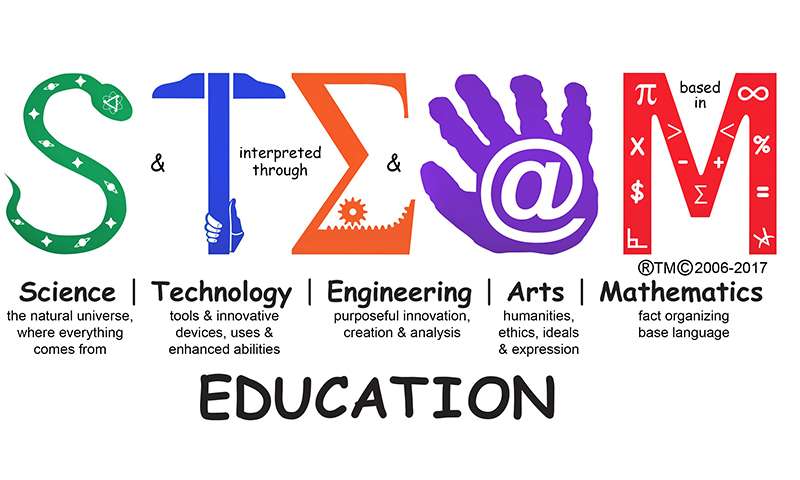
Definitions:
Reputed foundations & Institutes from around the world defines STEAM Education as:
STEAM Research based Definition:
Often seen written as, ST∑@M, this version denotes the definition most commonly cited for STEAM as not just an acronym to collect the fields, but one to show the order and purpose of how the subject fields relate in the societal development areas of the world. The goal of developing this framework was for teaching that could be based on natural ways of learning, customization for ALL types of students and programs and is Functional!
STEAM developing research drew heavily from STEM research, especially that of Dr. Dugger, Jr., the original editor of the International Technology and Engineering Educational Standards. His STEM definition has been one used widely, “The study of technology and engineering is not possible without the study of the natural sciences. This in turn cannot be understood in depth without a fundamental understanding of mathematics.” From that, the Integrative STEM program at Virginia Tech developed where Georgette Yakman began work on STEAM expanding the definition for the inclusion of how the liberal arts are formally related to STEM.
“Science & Technology interpreted through Engineering & the Arts, all understood with elements of Math”
National Science Foundation:
STEAM education is an interdisciplinary approach to teaching that integrates Science, Technology, Engineering, Arts, and Mathematics to promote problem-solving, critical thinking, and innovation.
American Institutes for Research:
STEAM education is a pedagogical approach that emphasizes the integration of Arts with Science, Technology, Engineering, and Mathematics to foster creativity, collaboration, and innovation.
Education Development Center:
STEAM education is an integrated approach to teaching and learning that uses real-world problem-solving, creativity, and interdisciplinary thinking to help students develop the skills they need to succeed in the 21st century workforce
International Society for Technology in Education:
STEAM education is a method of instruction that seeks to combine the creativity and critical thinking skills of the Arts with the analytical and problem-solving skills of Science, Technology, Engineering, and Mathematics to provide a holistic and well-rounded education.
These definitions highlight the interdisciplinary nature of STEAM education and its emphasis on real-world problem-solving, creativity, and innovation. By combining the arts with STEM subjects, STEAM education aims to provide students with a well-rounded education that prepares them for success in the 21st century workforce.
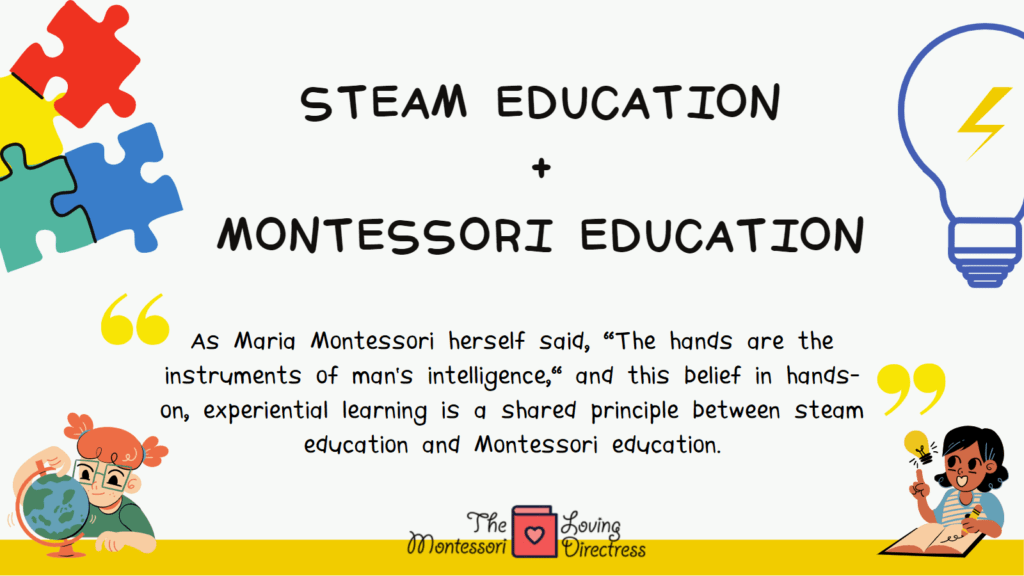
Shared principles of the Montessori method of teaching & STEAM Education:
The Montessori Method of Teaching:
The Montessori method of teaching was developed by Dr. Maria Montessori in the early 1900s. The method is based on the idea that children have a natural desire to learn, and that learning should be a self-directed, hands-on process. In Montessori education, children are given the freedom to explore and learn at their own pace, with teachers serving as facilitators rather than lecturers.
STEAM Education:
STEAM education, on the other hand, is a relatively new approach to education that incorporates the fields of science, technology, engineering, art, and math. STEAM education is based on the idea that these fields are interconnected and that students should be taught to think creatively and critically, and to solve problems in a collaborative way.
Shared Principles:
Despite their different origins and approaches, the Montessori method and STEAM education share several key principles that make them compatible approaches to education. These include:
Hands-on, experiential learning:
Both the Montessori method and STEAM education prioritize hands-on, experiential learning, which research has shown is more effective for promoting deeper learning and retention of information. According to a study by the University of Colorado, “Inquiry-based, hands-on learning is an effective way to teach science because it actively engages students in the learning process and helps them understand complex concepts.”
Child-centered approach:
Both Montessori and STEAM education are based on a child-centered approach to learning, where the focus is on the individual child’s needs and interests. According to a study by the University of Cambridge, “Child-centered learning approaches have been found to promote deeper learning and motivation, and to foster creativity and critical thinking.”
Collaboration and teamwork:
Both Montessori and STEAM education emphasize the importance of collaboration and teamwork, which research has shown to be essential for promoting social-emotional skills and preparing students for the workforce. According to a study by the University of Southern California, “Collaborative learning experiences help students develop important interpersonal and teamwork skills, and can lead to higher academic achievement.”
Process over product:
Both Montessori and STEAM education emphasize the importance of the learning process itself, rather than simply focusing on the end product. According to a study by the University of Illinois, “Focusing on the process of learning, rather than just the outcome, can help students develop critical thinking skills and a deeper understanding of the subject matter.”
Combining Montessori and STEAM Education:
Given their shared principles, it is not surprising that many educators are now exploring ways to combine Montessori and STEAM education. This integration is seen as a way to provide children with a well-rounded, interdisciplinary education that fosters creativity, critical thinking, and problem-solving skills.
One example of this integration can be seen in the Montessori STEAM Academy in Michigan, which was founded in 2013. The academy combines the Montessori method with STEAM education, providing children with hands-on, experiential learning opportunities in science, technology, engineering, art, and math. According to the academy’s website, “Our goal is to provide children with a 21st-century education that prepares them for the challenges of the future while honoring the principles of the Montessori method.”
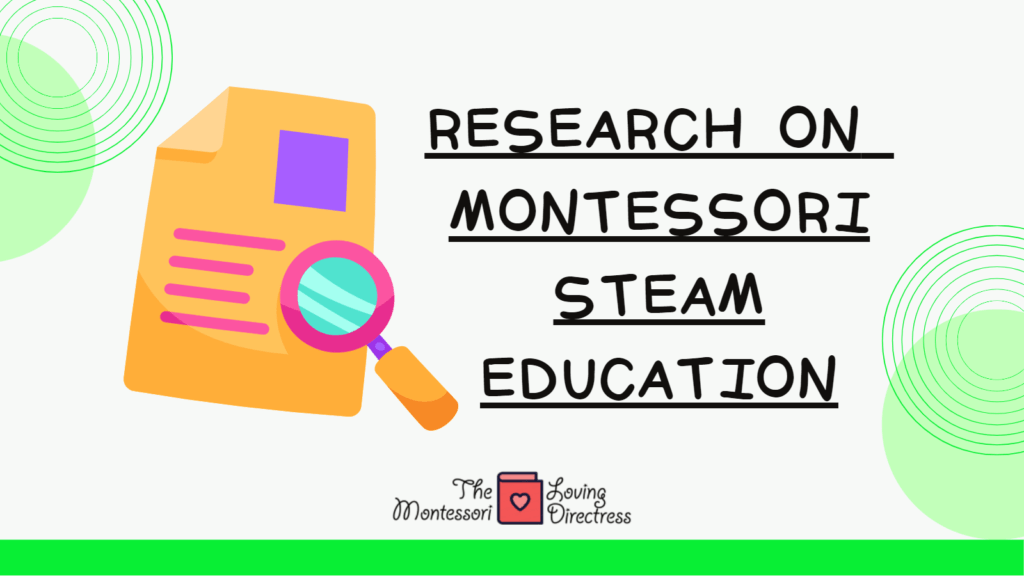
Effectiveness of Montessori STEAM Education:
Montessori STEAM education is an approach that combines the principles of the Montessori method of education with the STEAM (science, technology, engineering, arts, and mathematics) curriculum. This approach aims to promote hands-on learning experiences, problem-solving skills, and critical thinking abilities in children. Several studies have been conducted to evaluate the effectiveness of Montessori STEAM education.
- A study conducted by M. Chiu and M. Churchill (2018) found that integrating STEAM education into the Montessori curriculum can help improve problem-solving skills in children. The study involved 123 children aged 3 to 6 years who attended a Montessori school that incorporated STEAM education. The researchers found that the children demonstrated significant improvements in their problem-solving abilities after participating in STEAM activities.
- Another study conducted by J. Chabrier and J. H. Van Horn (2019) evaluated the impact of a Montessori STEAM program on the academic performance of elementary school children. The study involved 179 students in grades 3 to 6 who participated in the program. The researchers found that the Montessori STEAM program had a positive effect on the students’ academic performance, particularly in science and mathematics.
- A study conducted by C. Koepke and D. Doherty (2018) evaluated the effectiveness of a Montessori STEAM program in improving student engagement and achievement. The study involved 20 kindergarten students who participated in a Montessori school that incorporated STEAM education. The researchers found that the Montessori STEAM program led to increased student engagement and improved academic achievement, particularly in science and mathematics.
- In a study conducted by J. S. Yi, J. A. Kang, and J. Kim (2021), the researchers evaluated the effectiveness of a Montessori STEAM program in developing creativity and critical thinking skills in preschool children. The study involved 35 children aged 4 to 5 years who participated in the program. The researchers found that the Montessori STEAM program had a positive impact on the children’s creativity and critical thinking abilities.
Overall, these studies suggest that Montessori STEAM education can be an effective approach in promoting hands-on learning experiences, problem-solving skills, critical thinking abilities, and academic performance in children.
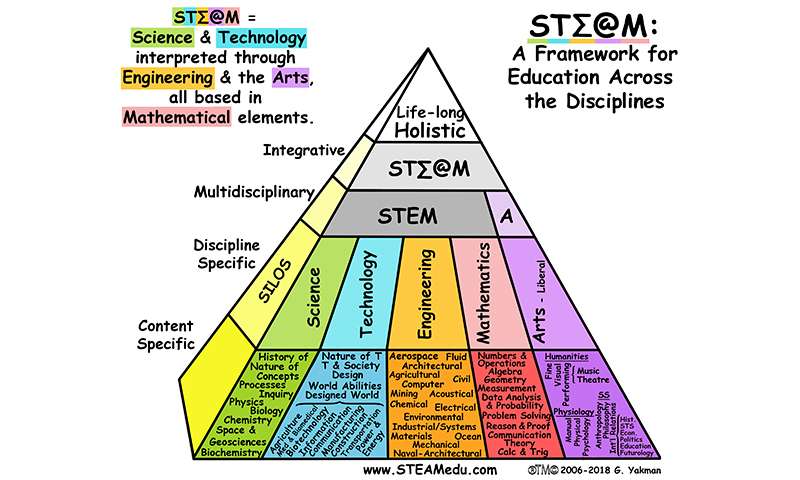
Montessori and STEAM Education: Similarities and Differences
The Montessori method of education and STEAM education have some similarities and differences in their approaches to teaching and learning.
Similarities:
Child-centered approach: Both Montessori and STEAM education place the child at the center of learning. The learning process is designed to be child-led, with teachers acting as facilitators rather than lecturers.
Emphasis on hands-on learning: Both Montessori and STEAM education prioritize hands-on learning experiences. Children are encouraged to explore and experiment with materials to gain a deeper understanding of concepts.
Focus on the process rather than the product: Both Montessori and STEAM education value the process of learning over the end result. The emphasis is on the journey rather than the destination.
Differences:
Curriculum: The Montessori method has a structured curriculum that is based on the developmental needs of children. STEAM education, on the other hand, is a framework that integrates science, technology, engineering, arts, and math into existing curricula.
Creativity: While both approaches emphasize hands-on learning, the Montessori method places a greater emphasis on fostering creativity and imagination in children. STEAM education, on the other hand, focuses on problem-solving and critical thinking.
Teacher role: In Montessori education, teachers play a more active role in guiding children through the learning process. In STEAM education, teachers take on a more facilitative role, allowing children to explore and learn independently.
Research:
A study conducted by E. Gordon and L. Browne compared the Montessori method of teaching with traditional education and found that the Montessori method led to greater cognitive and social development in children. Another study conducted by Lillard and Else-Quest compared Montessori education with other forms of early childhood education and found that Montessori children performed better on academic and social outcomes.
In a study conducted by C. Koepke and D. Doherty, it was found that integrating STEAM education into the Montessori curriculum can lead to improved student engagement and achievement. Another study conducted by M. Chiu and M. Churchill found that STEAM education can help improve problem-solving skills in children.
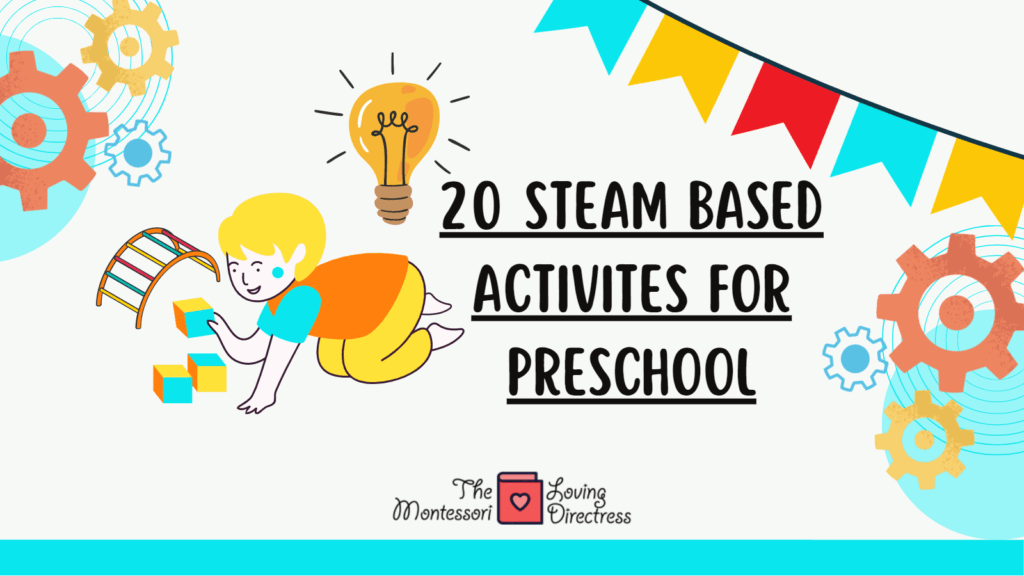
20 STEAM based activities for Preschoolers:
Build with blocks:
Encourage preschoolers to build structures using blocks of different shapes and sizes. This activity promotes spatial reasoning and creativity.
Explore magnets:
Provide preschoolers with a variety of magnets and objects to experiment with, such as metal objects and magnetic letters. This activity introduces them to basic physics concepts.
Conduct science experiments:
Conduct simple science experiments with preschoolers, such as mixing vinegar and baking soda to create a reaction. This activity helps them develop an understanding of cause and effect.
Create art using recycled materials:
Provide preschoolers with a variety of recycled materials, such as paper rolls, bottle caps, and cardboard boxes, and encourage them to create art. This activity promotes creativity and environmental awareness.
Plant a garden:
Planting a garden with preschoolers teaches them about the life cycle of plants and promotes responsibility and caretaking skills.
Sort and classify objects:
Provide preschoolers with a variety of objects and encourage them to sort and classify them based on different attributes, such as size, shape, and color. This activity promotes early math skills.
Build structures using playdough:
Encourage preschoolers to build structures using playdough. This activity promotes fine motor skills and creativity.
Create a musical instrument:
Provide preschoolers with materials such as cardboard tubes and rubber bands and encourage them to create their own musical instruments. This activity promotes creativity and an understanding of sound and vibrations.
Build a bridge:
Provide preschoolers with materials such as popsicle sticks and glue and encourage them to build a bridge. This activity promotes problem-solving skills and an understanding of basic engineering concepts.
Build a birdhouse:
Provide preschoolers with materials such as a small wooden birdhouse kit and encourage them to assemble it. This activity promotes problem-solving skills and an understanding of basic construction concepts.
Create a marble run:
Provide preschoolers with materials such as cardboard tubes and paper cups and encourage them to build a marble run. This activity promotes problem-solving skills and an understanding of basic physics concepts.
Make a volcano:
Create a simple volcano using materials such as baking soda and vinegar. This activity teaches preschoolers about chemical reactions and geology.
Design a car:
Provide preschoolers with materials such as cardboard, paper cups, and plastic wheels and encourage them to design and build their own cars. This activity promotes creativity and an understanding of basic engineering concepts.
Play with water:
Provide preschoolers with various containers and materials such as funnels and sponges and encourage them to play with water. This activity promotes sensory exploration and an understanding of basic physics concepts.
Build a tower:
Provide preschoolers with materials such as blocks, cups, and cardboard tubes and encourage them to build a tower. This activity promotes spatial reasoning and problem-solving skills.
Create a stop-motion animation:
Provide preschoolers with materials such as clay and a smartphone or tablet and encourage them to create a stop-motion animation. This activity promotes creativity and an understanding of basic animation concepts.
Conduct a sink or float experiment:
Provide preschoolers with a variety of objects and encourage them to predict whether they will sink or float in water. This activity promotes scientific thinking and an understanding of basic physics concepts.
Explore colors:
Provide preschoolers with materials such as paint, paper, and mixing trays and encourage them to explore and mix colors. This activity promotes artistic expression and an understanding of basic science concepts.
Build a fort:
Provide preschoolers with materials such as blankets and pillows and encourage them to build a fort. This activity promotes creativity and an understanding of basic engineering concepts.
Create a simple machine:
Provide preschoolers with materials such as pulleys and levers and encourage them to create a simple machine. This activity promotes problem-solving skills and an understanding of basic physics concepts.

STEAM Education & Digital Literacy
Digital literacy is a critical skill in the 21st century. With technology advancing at an unprecedented pace, it is essential for students to develop digital literacy skills in order to succeed in the future workforce. In this article, we’ll explore the importance of digital literacy in STEAM education, as well as strategies for incorporating digital literacy into the classroom.
What is Digital Literacy?
Digital literacy refers to the ability to use digital tools and technologies effectively to find, evaluate, create, and communicate information. Digital literacy is essential in the 21st century, as it enables individuals to navigate the rapidly changing digital landscape and stay informed and engaged in a variety of contexts.
Importance of Digital Literacy in STEAM Education
Digital literacy is an essential component of STEAM education, as it enables students to:
Access and analyze digital information:
Digital literacy skills enable students to find, evaluate, and analyze digital information from a variety of sources.
Use digital tools and technologies:
Digital literacy skills enable students to use digital tools and technologies to create and communicate information in a variety of formats.
Develop critical thinking skills:
Digital literacy skills enable students to develop critical thinking skills by analyzing and evaluating digital information and sources.
Collaborate and communicate effectively:
Digital literacy skills enable students to collaborate and communicate effectively in a digital environment, which is increasingly important in the global workforce.
Strategies for Incorporating Digital Literacy into the Classroom:
Incorporating digital literacy into the classroom requires careful planning and preparation. Here are some strategies for incorporating digital literacy into STEAM education:
Teach digital literacy skills explicitly:
Digital literacy skills should be taught explicitly, with a focus on developing specific skills such as search strategies, evaluation of sources, and digital communication.
Use digital tools and technologies in the classroom:
Teachers should incorporate digital tools and technologies into the classroom to provide students with opportunities to develop digital literacy skills in a real-world context.
Encourage collaboration and communication:
Teachers should encourage collaboration and communication in a digital environment, using tools such as online discussion forums and collaborative document editing.
Promote responsible digital citizenship:
Teachers should promote responsible digital citizenship by teaching students about online safety, privacy, and security.
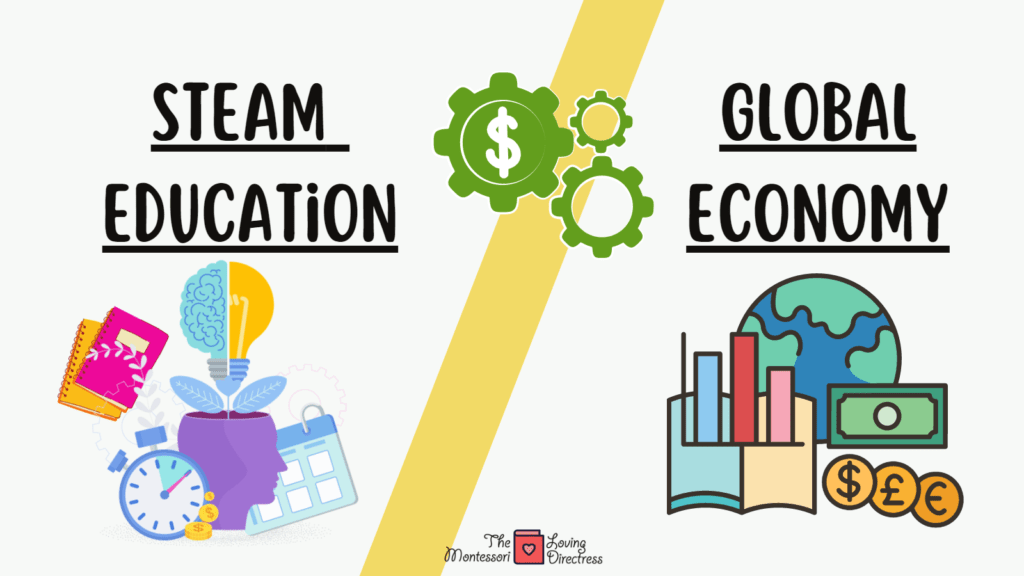
STEAM Education and the Global Economy: How It Impacts Job Markets and Skills Development:
The global economy is undergoing a major transformation, with technological advancements and automation driving significant changes in the job market. As a result, the demand for workers with STEAM skills has increased, and the ability to adapt to new technologies and ways of working has become essential for career success.
The Rise of Automation and Artificial Intelligence:
One of the key drivers of the demand for STEAM skills is the rise of automation and artificial intelligence (AI). Many routine tasks that were previously performed by humans can now be automated, leading to a shift in the types of skills that are required in the workforce. Jobs that require creativity, problem-solving, and critical thinking are becoming increasingly important, as these are skills that are difficult to automate.
Preparing for the Jobs of the Future:
STEAM education plays a critical role in preparing individuals for the jobs of the future. By teaching students to think creatively, work collaboratively, and develop problem-solving skills, STEAM education helps prepare them for the changing demands of the global economy. Additionally, STEAM education provides individuals with the technical skills and knowledge necessary to work with new technologies and adapt to new ways of working.
Government Support for STEAM Education:
In many countries, there is a growing recognition of the importance of STEAM education in preparing students for the jobs of the future. Governments and educational institutions are investing in STEAM education programs and initiatives to help develop the necessary skills and knowledge in students.
For example, in the United States, the National Science Foundation (NSF) provides funding for STEAM education initiatives and research projects. Similarly, the European Union has launched the Horizon 2020 initiative, which aims to support research and innovation in STEAM education and other areas.
Impact on Job Markets and Skills Development:
The demand for workers with STEAM skills is likely to continue to grow in the coming years, driven by the rapid changes in the global economy. As a result, STEAM education is likely to become even more important in preparing individuals for the jobs of the future and helping to drive innovation and economic growth.
Additionally, the impact of STEAM education on job markets and skills development is not limited to traditional technology-related fields. STEAM skills are increasingly important in fields such as healthcare, finance, and marketing, where the ability to analyze data and think critically is essential.
Conclusively, the demand for workers with STEAM skills is likely to continue to grow in the coming years, driven by the rapid changes in the global economy. STEAM education plays a critical role in preparing individuals for the jobs of the future and helping to drive innovation and economic growth. Governments, educational institutions, and the private sector are all investing in STEAM education programs and initiatives to help develop the necessary skills and knowledge in students and workers. By embracing STEAM education, individuals can position themselves for success in the rapidly evolving job market and contribute to the growth and development of the global economy.
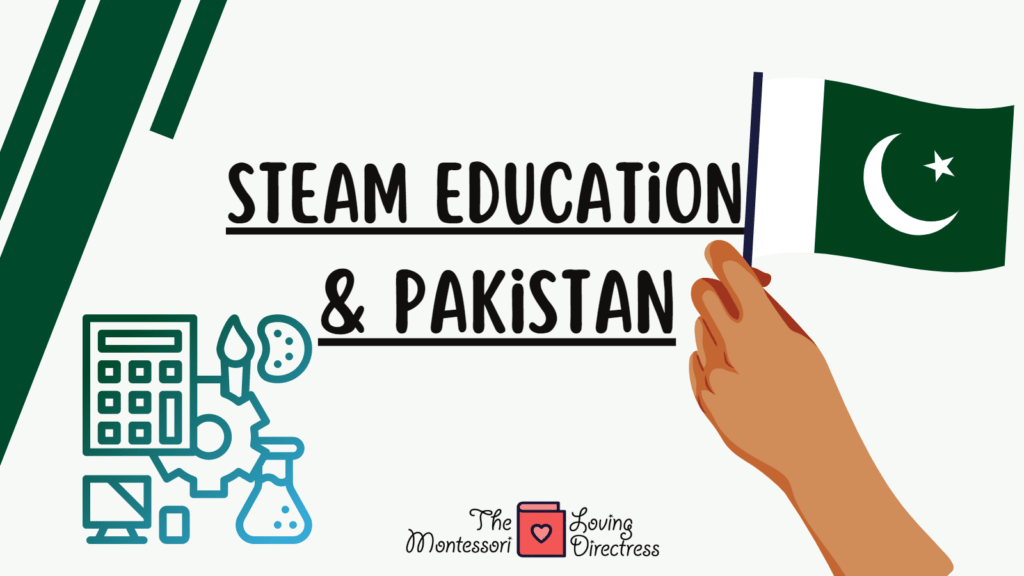
Pakistan’s Journey to STEAM Education: A Positive Outlook:
Pakistan, a developing country with a population of over 220 million, has been investing in education reforms to provide quality education to its citizens. One of the recent additions to the education system in Pakistan is the integration of STEAM (Science, Technology, Engineering, Arts, and Mathematics) education. This integration has been widely welcomed by educators, policymakers, and parents, as it is believed to have the potential to transform the education system and provide more opportunities for the youth in the country.
Positive Steps Towards STEAM Education in Pakistan:
In recent years, there have been several initiatives taken by the government, private sector, and non-profit organizations to promote STEAM education in Pakistan. One such initiative is the establishment of STEAM labs in public schools across the country. These labs are equipped with the latest technology and resources, and they provide students with hands-on learning experiences to develop their problem-solving and critical thinking skills.
The government has also launched various programs to promote STEAM education in the country. For instance, the National Science, Technology, Engineering, and Mathematics (STEM) School Program was launched in 2016 to provide students with quality education in STEM subjects. Additionally, the government has established the Pakistan Innovation Foundation to promote innovation and entrepreneurship in the country.
Private sector organizations have also played a significant role in promoting STEAM education in Pakistan. For example, Google has launched its “Code to Learn” program in Pakistan, which aims to teach coding skills to young students. Similarly, the Engro Foundation has established the Engro Schools, which focus on providing quality education in STEM subjects.
The Role of Non-profit Organizations:
Non-profit organizations have also been actively promoting STEAM education in Pakistan. One such organization is the Pakistan Alliance for Maths and Science (PAMS), which focuses on promoting science education in the country. PAMS has been organizing science festivals and competitions to engage students in science and math subjects.
Another non-profit organization, the Society for Science Education (SSE), has been organizing workshops and training programs for teachers to develop their skills in teaching science and math subjects. Additionally, SSE has launched the STEM Careers Program, which aims to provide students with career guidance in STEM fields.
Impact of STEAM Education in Pakistan
The integration of STEAM education in Pakistan has had a positive impact on the education system in the country. It has provided students with opportunities to develop their problem-solving and critical-thinking skills, which are essential in the 21st century. Furthermore, it has helped to bridge the gap between theoretical knowledge and practical application, which has been a major challenge in the education system in Pakistan.
According to a study conducted by the Lahore University of Management Sciences, students who had access to STEAM education showed better performance in science and math subjects as compared to students who did not have access to such education. Moreover, the study found that STEAM education had a positive impact on student’s attitudes towards science and math subjects, which is crucial for developing an interest in these subjects.
The integration of STEAM education in Pakistan has been a positive step towards providing quality education to the youth in the country. The initiatives taken by the government, private sector, and non-profit organizations have helped to promote STEAM education and provide students with opportunities to develop their skills in science, technology, engineering, arts, and math subjects. While there is still a long way to go, the positive impact of STEAM education in Pakistan is evident and holds great promise for the future of education in the country.
Research-Based Reports:
There have been some research-based reports on STEAM Education in Pakistan. Here are a few examples:
- A report by the Higher Education Commission of Pakistan titled “STEM Education in Pakistan: Challenges and Opportunities” highlights the importance of STEM Education in Pakistan and the challenges that need to be addressed to improve its quality. The report recommends improving teacher training, increasing funding for STEM programs, and promoting industry-academic partnerships.
- The Lahore School of Economics conducted a study titled “Impact of STEAM Education on Creativity and Problem-Solving Skills: Evidence from Pakistan.” The study found that students who participated in a STEAM program had higher levels of creativity and problem-solving skills than students who did not participate in the program.
- The Pakistan Institute of Development Economics conducted a study titled “The Returns to Education in Pakistan: Evidence from the Pakistan Social and Living Standards Measurement Survey 2014-15.” The study found that students who specialized in STEM subjects had higher levels of academic achievement and were more likely to pursue higher education.
These research-based reports provide valuable insights into the current state of STEAM Education in Pakistan and highlight the need for improvements in teacher training, funding, and industry-academic partnerships to further promote and enhance STEAM Education in the country.
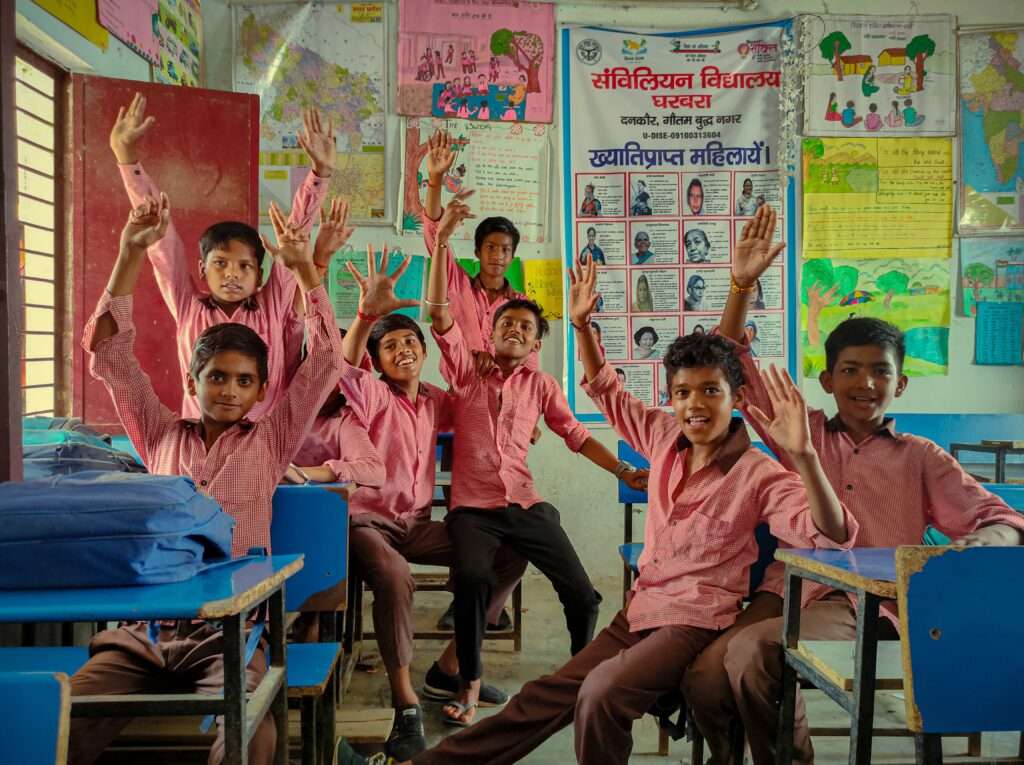
Drawbacks of STEAM Education:
While STEAM education has many potential benefits, there are also some drawbacks that should be considered. Here are a few drawbacks of STEAM education:
Implementation challenges:
One of the main challenges with STEAM education is the difficulty of implementing it effectively in the classroom. Integrating different subjects into a cohesive lesson plan can be challenging, and teachers may need additional training and resources to effectively implement STEAM education.
Limited access to resources:
STEAM education often requires access to specialized resources, such as equipment for robotics or 3D printing, which may not be available in all schools. This can create inequality in access to STEAM education and limit its effectiveness.
Lack of standardized assessment:
There is currently no standardized assessment tool for STEAM education, which can make it difficult to evaluate the effectiveness of STEAM programs and compare them to traditional educational approaches.
Increased workload for teachers:
STEAM education often requires teachers to create interdisciplinary lesson plans and integrate different subjects, which can be time-consuming and increase workload. This can lead to burnout and limit the sustainability of STEAM education programs.
Potential for neglecting core subjects:
In some cases, the emphasis on interdisciplinary STEAM education may result in neglecting core subjects, such as math and reading, which are critical for academic success.
These drawbacks highlight some of the challenges of implementing STEAM education effectively and the potential for unintended consequences, such as neglecting core subjects. However, with proper planning, training, and resources, these challenges can be addressed to ensure that STEAM education is effective and equitable for all students.
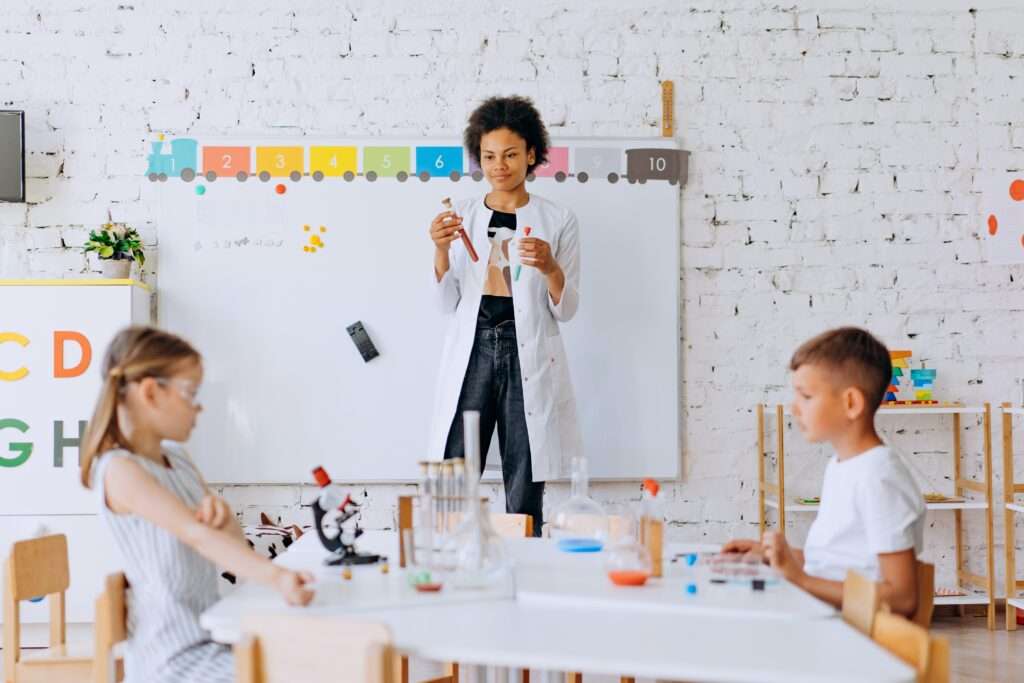
Skills of a STEAM Teacher:
As technology continues to play a significant role in education, teachers are increasingly using platforms like Steam (Science, Technology, Engineering, Arts, and Mathematics) to make learning more engaging and interactive for their students. As such, it is becoming more important for teachers to have the skills necessary to incorporate Steam into their lessons effectively. In this article, we will explore what to look for when you are becoming a Steam teacher.
Familiarity with the Steam approach:
The Steam approach is an interdisciplinary approach to learning that emphasizes the integration of science, technology, engineering, art, and mathematics. As such, it is essential for Steam teachers to be familiar with the principles behind this approach and how to apply them in their teaching. This involves having a good understanding of the latest trends and developments in Steam education.
Passion for teaching:
A passion for teaching is a critical characteristic of a successful Steam teacher. Teachers who are passionate about their work are more likely to inspire and motivate their students, creating a positive learning environment. Furthermore, a teacher who is passionate about Steam education will find innovative ways to incorporate the latest technologies and approaches to enhance the learning experience for their students.
Strong technological skills:
Steam education involves the use of technology to teach and learn. As such, it is crucial for Steam teachers to be comfortable with technology and have the skills necessary to integrate it into their lessons effectively. This includes having a good understanding of educational software, coding languages, and other technological tools that can be used in Steam education.
Ability to collaborate:
Collaboration is an essential aspect of Steam education, as it involves the integration of different subject areas. A Steam teacher should be able to work well with other teachers, particularly those who specialize in different subject areas. This collaboration will help to create a cohesive learning experience for students, allowing them to make connections between different subject areas.
Creative thinking skills:
Steam education involves a lot of creative thinking, as teachers must find innovative ways to incorporate the different subject areas into their lessons. A Steam teacher should have strong creative thinking skills, allowing them to come up with unique lesson plans that are engaging and effective.
Patience and flexibility:
Steam education can be challenging, and teachers may need to adjust their lessons on the fly to accommodate different learning styles and abilities. Patience and flexibility are essential characteristics of a successful Steam teacher, as they allow teachers to adapt their lessons to meet the needs of their students.
Becoming a Steam teacher requires a combination of technical knowledge, passion for teaching, and creative thinking skills. Steam teachers should have a good understanding of the principles behind the Steam approach and the latest trends and developments in Steam education. Additionally, they should be comfortable with technology and able to collaborate effectively with other teachers. With these skills and characteristics, Steam teachers can create a positive and engaging learning environment that will inspire and motivate their students to succeed.
Free STEAM Booklet:

Conclusion:
In conclusion, the implementation of STEAM education in schools has the potential to revolutionize the traditional education system by providing a more practical and holistic approach to learning. Through the integration of Science, Technology, Engineering, Arts, and Mathematics, STEAM education allows students to develop a range of skills, including critical thinking, problem-solving, collaboration, creativity, and innovation.
Moreover, STEAM education encourages students to apply their theoretical knowledge to real-world situations, thus preparing them for future careers and challenges. The incorporation of hands-on activities, project-based learning, and inquiry-based teaching methods in STEAM education fosters a love for learning, boosts student engagement, and enhances academic achievement.
In today’s rapidly evolving world, where technology is advancing at an unprecedented pace, STEAM education is crucial for producing a skilled and competent workforce that can adapt to the changing needs of society. Therefore, it is essential for educators and policymakers to prioritize and invest in STEAM education to ensure that future generations are equipped with the necessary skills to succeed in the 21st-century workforce.


Its like you read my mind! You appear to know so much about this, like you wrote the book in it or something. I think that you could do with a few pics to drive the message home a little bit, but instead of that, this is fantastic blog. A fantastic read. I will certainly be back.